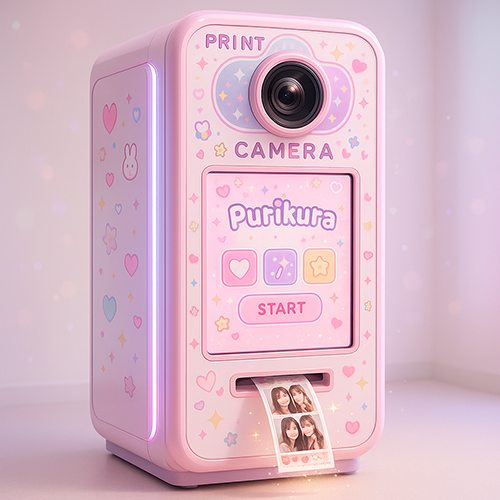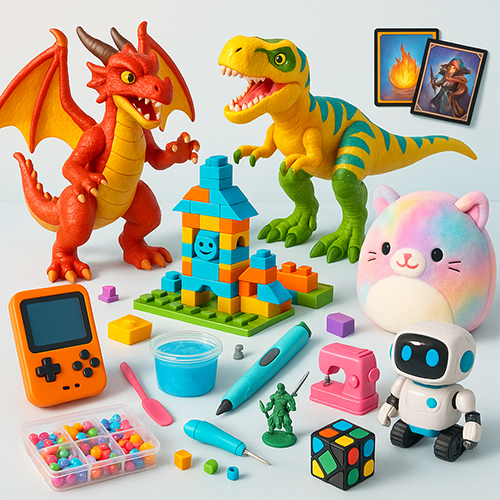The toy world never stands still — trends constantly shift, and each country has its own hit innovations. By the end of 2025, the industry clearly shows several global tendencies such as tech‑enhanced smart toys, collectible surprise series, and eco‑friendly products, yet regional preferences remain unique. Let’s explore which toys for children and teenagers are especially popular today in Russia, Asian countries, Europe, and America — and how tastes differ between younger kids and teens.
CIS
Russian children quickly pick up global viral trends from social media and love cute plush toys, unusual stress‑relief items, and tech novelties. Teenagers in Russia are increasingly interested in collectible figurines and gadgets, while also keeping an eye on meme‑based toys from the internet.
A separate hit category is stress‑relief toys and squishies. The brightest example is the “Tabby Paw,” a stretchy, sticky “cat paw” that kids like to squeeze in their hands and throw at the ceiling so it sticks. Teachers may not be thrilled, but nearly every student now has one in their pencil case or backpack. The popularity of simple pop‑its, slimes, and soft stress‑relief pillows also remains strong — these help children relax and ease anxiety during the daily school routine.

Among teens, interests shift towards internet trends, technology, and collecting. Collectible surprise toys have become a true cult: figurines in blind‑box sets are popular among both teenagers and even adults. For example, the Chinese mini‑figures Labubu unexpectedly entered the Russian market in spring 2025. At first, they were mostly bought by adult collectors, but now teenagers enjoy showing off rare Labubu pieces from limited series as well.
Besides Labubu, teens also collect other figurines from games and films — from Japanese Sonny Angel to the familiar Funko Pop. The blind‑box trend has swept the youth market: many chase rare figures from limited runs, trade duplicates, and film unboxing videos for TikTok. Anything that goes viral on social media — whether an unusual puzzle or a new stress‑relief toy — instantly becomes a must‑have among teenagers.
Fans of more advanced electronic gadgets prefer drones and quadcopters, great for amateur aerial photography. Affordable children’s models with cameras teach coordination and allow taking photos and videos from above, bringing playtime to a new level. Many start with a toy‑grade quadcopter and later develop a serious interest in aerial photography or model aviation. Teens also appreciate complex scientific construction kits (programmable robot platforms, electronics), which often become a first step into the world of robotics.
Asia
The Asian toy market is one of the most innovative and diverse in the world. In Japan and China, the kidult trend is booming — toys for teenagers and adults have opened a new consumer segment amid declining birth rates. Children in Asia still adore anime merchandise and game‑related characters, while teens increasingly collect figurines and miniature capsule toys.
Children in Asian countries have a deep attachment to characters from local pop culture. Almost every child is a fan of some anime or video game, so toy collaborations with famous franchises fly off the shelves. At the 2025 Tokyo Toy Show, many examples of such partnerships were showcased. For instance, a series combining Sega’s Sonic with Sanrio characters — Sonic alongside Hello Kitty and others — caused immediate excitement among fans. Japan’s iconic Licca‑chan doll appeared in special editions dressed as anime characters (e.g., Detective Conan) and even with Hello Kitty and Kuromi accessories. These collaborative toys attract children by uniting their favorite characters in new, unexpected forms.
Asia is also seeing a trend toward interactive creative gadgets — a blend of technology and play. In South Korea, instant digital‑print cameras became fashionable. The PRINT CAMERA Purika allows kids to take photos and immediately print them on long receipt‑like strips. These black‑and‑white “retro photos” became a hit among students who love vintage effects. The trend spread from Korea to Japan and across Asia, offering new hobbies to young people tired of perfect digital quality. Classic electronic pets like Tamagotchi continue developing as well: modern versions have internet connectivity and new features but still teach kids to care for a virtual companion.

Teenagers largely shape global trends, especially in collectible and designer toys. They are avid collectors of blind‑box figures and capsule machines. Every week, major companies like China’s Pop Mart release new surprise series to keep fans engaged. The most popular series include Labubu, the adorable Sonny Angel figures, and toys inspired by Sanrio, Disney, and other global brands. Hunting for rare items has become a sport for Asian youth: communities exist for trading duplicates, and rare pieces resell for hundreds of dollars. Giant capsule‑toy stores are opening in Japan and China where teens spend hours trying to complete collections. Social media supports this craze — blind‑box unboxing videos gather millions of views, drawing in more fans.
At the same time, the “kidult” trend flourishes — toys originally designed for adults but equally appealing to older teens. For example, at the 2025 Tokyo Toy Fair, an AI‑enhanced meerkat robot was introduced specifically for women aged 20–30 as an “electronic companion pet.” Teens find such innovations interesting too, as boundaries between “for kids” and “for adults” continue to blur. Many high‑schoolers in Japan enjoy assembling Gundam models (traditionally an adult hobby), large‑scale superhero figures, and advanced RC cars. High‑tech toys — from drones to VR headsets — are also on their wishlists, reflecting Asia’s rapid adoption of new entertainment technologies.
Europe
In Europe, children’s preferences largely align with global trends but have unique accents. European parents prioritize quality and safety, and eco‑friendly toys made from natural materials are highly popular. Children gravitate toward internationally recognized brands (Disney cartoons, series, games), as well as internet‑driven trends (viral stress‑relief toys, collectibles).
European kids love characters from popular cartoons and films, and 2025 brought many new favorites. By Christmas, top sellers in the UK included playsets from the “Bluey” series, dolls from “Moana 2,” and dinosaur toys from “Jurassic World.” Classic brands remain strong — Barbie continues inspiring girls, especially after the 2023 film buzz, and LEGO consistently ranks among the most desired gifts. In 2025–2026, LEGO released numerous sets themed around wildlife and engineering, sustaining children’s interest in construction.

Of course, European kids also follow global internet phenomena. Any viral toy (like TikTok stress‑relief springs or new slime varieties) quickly appears on shelves and becomes a bestseller. Manufacturers understand that modern kids spend much time online and aim to produce toys that can be customized. Creative kits have surged in popularity: DIY slime, stained‑glass painting sets, 3D‑printing pens, and even children’s sewing machines — anything that helps a child express individuality.
European teenagers in 2025 are also captivated by major trends — from collecting toys like Labubu and Crybaby to acquiring items popularized on TikTok. Experts note growing nostalgia among teens and adults: cute collectible figurines evoke “child‑like joy.” In 2025, a truck carrying toys worth £150,000 was even stolen in England, highlighting the high demand for these rare items. Funko Pop figures remain trendy as well — many teens decorate their rooms with them.
Board games also remain popular worldwide. Dungeons & Dragons and other tabletop games continue rising in popularity — many teens prefer in‑person time with friends, which has become fashionable amid digital fatigue. Modern board games come in beautifully designed editions with miniatures, adding aesthetic appeal. Puzzle toys (like the Rubik’s Cube or Kanoodle) also stay relevant for stress relief and the satisfying sense of mastery they provide.
USA
In North America (especially the US), the toy market is huge and diverse. American children easily engage with new film and TV franchises and enjoy active toys for indoor and backyard play. Educational and STEM kits are popular — parents appreciate toys that entertain and teach. US teenagers frequently shift to gadgets and video games but still show interest in collectible figurines, board games, and social activities. The American market also sets global trends through Hollywood releases and social media — many viral toy crazes originate here before spreading worldwide.
American children at the end of 2025 are captivated by toys from favorite movies and creative kits. Analysts predict that wishlists for the holidays will be dominated by hot licenses — figurines and dolls from new parts of “How to Train Your Dragon,” “Moana 2,” sets from “Bluey,” and fresh launches from Jurassic World and Minecraft. Old favorites also return in new forms — Barbie got new themed sets, and the legendary Furby came back with updated design and features. Kids aged 6–8 still adore Marvel and DC heroes — new superhero films in 2025–2026 ensure demand for action figures and costumes.
A notable trend is DIY fashion and creativity. Children want to create and customize their toys. As a result, DIY slime kits, jewelry‑making sets, 3D‑printing pens, and even toy sewing or pottery machines sell extremely well. These products keep kids busy while letting them feel like inventors. According to Good Housekeeping, top innovations of 2025 include DIY accessories and clothing kits, as well as Squishmallows construction sets (now plush squishies can be assembled like LEGO). Kids aged 9–12 also love the new Kanoodle SudoQube — a 3D Sudoku puzzle popular among adults as well. In general, smart games and puzzles are in demand: parents seek toys that develop STEAM skills while remaining fun. Electronic science kits (like Snap Circuits), interactive globes, and programmable robots are all performing well.

American teens largely gravitate toward digital entertainment (smartphones, consoles), yet physical toys still capture their interest. One major category is tabletop and collectible card games. In high school, it’s trendy again to gather and play — whether strategic RPGs like Dungeons & Dragons (experiencing a boom thanks to series and livestreams) or fast card games like UNO and Exploding Kittens. Many teens collect cards (Magic: The Gathering, Pokémon TCG), exchange them, and join local tournaments. Some US schools even have hobby clubs dedicated to board gaming and tabletop RPGs — far more common now than a decade ago.
Fandom culture remains strong: teens still want figurines of characters from films, series, and anime. New Star Wars or Marvel releases lead to spikes in toy sales — collectible helmets, glowing lightsabers, figurines, and more. Interestingly, many teens share these hobbies with their parents. Studies show that 76% of millennial parents enjoy playing with toys from shared favorite franchises — building Star Wars figure collections or playing D&D campaigns together. 73% of parents admit to buying toys for themselves, and almost half of adults collect or play to relive childhood joy. US manufacturers therefore actively produce updated versions of classic toys, targeting nostalgia. In 2025, for example, updated mini‑versions of 1980s game consoles, retro figurines (Mario, Sonic), and new Bratz dolls (popular in the 2000s) are anticipated — all appealing to both teens and parents.
Toy preferences among children and teenagers at the turn of 2025–2026 are generally similar across countries. Everywhere, we see growing interest in technology, interactivity, personalization, and nostalgia. Collectible and surprise series dominate markets from Asia to Europe, while eco‑friendliness and educational value matter to parents worldwide. The global toy industry is increasingly bringing generations and cultures together. Modern kids and teens easily transition from VR gameplay to a board‑game night with friends, from collecting Chinese figurines to hugging classic plush bears. Manufacturers strive to satisfy everyone: those who want to learn through play and those who simply want fun and relaxation. The coming 2026 year will surely bring new bright trends — perhaps the next global hit will grow from a small local craze, uniting children across the planet in the joy of play.
Immerse yourself in the “Toy World” at the ChristmasBox Podarki fair!
